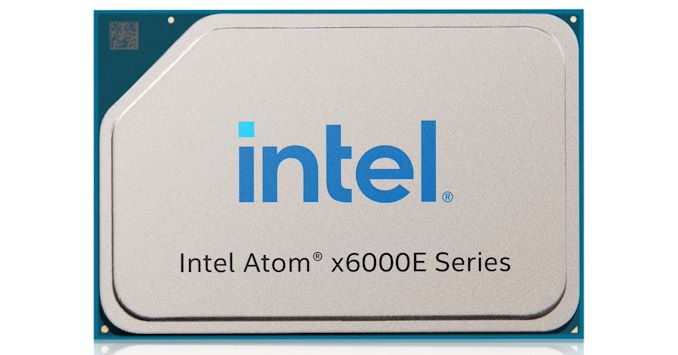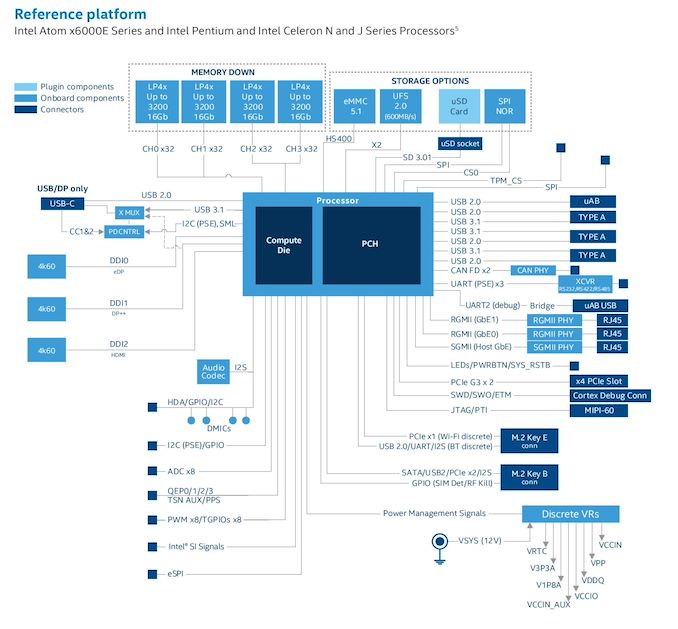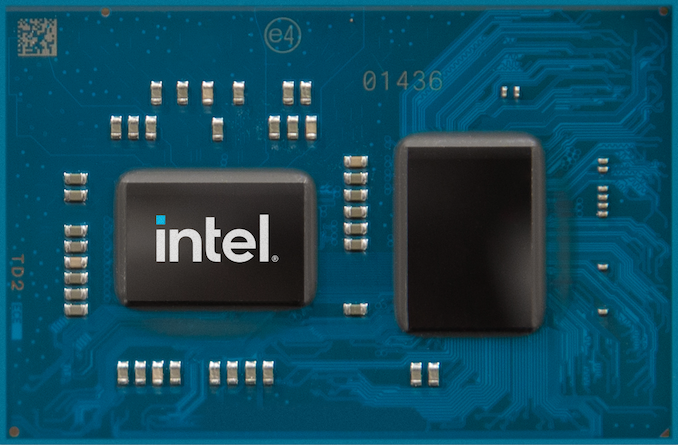Intel Launches 10nm Atom Embedded CPUs: Elkhart Lake Now Available
by Dr. Ian Cutress on September 23, 2020 9:00 AM EST
The embedded and edge markets for Intel have always been hidden away within its IoT business, however at the Investor Meeting last year it was highlighted as one of Intel’s key growth areas. The requirements for businesses to enable automation and control, as well as apply machine learning or computer vision, have increased as new optimized algorithms and use cases enter the market, and this is the question that the new 10nm Atom Embedded CPUs are set to answer.
Elkhart Lake built upon Tremont with 10nm
The new processors built with Tremont Atom cores will come as three series of processors: Pentium, Celeron, and Atom x6000E. These are all built with the same silicon die, offering up to four Atom cores with a 3.0 GHz turbo frequency, up to 850 MHz of Gen11 graphics (up to 32 EUs, three 4K60 displays), in TDPs ranging from 4.5 W to 12 W. All processors will support up to LPDDR4X-4267 or DDR4-3200. In-band ECC support is split - the Atom x6000E parts have it, but the Pentium and Celerons do not.
| Intel Elkhart Lake Tremont Atoms for Embedded |
||||||||
| AnandTech | Cores | Base MHz |
Turbo MHz |
GPU Base |
GPU MHz |
TDP |
TCC | TSI |
| Pentium J/N and Celeron J/N | ||||||||
| Pentium J6425 | 4 | 1800 | 3000 | 400 | 850 | 10W | - | - |
| Celeron J6413 | 4 | 1800 | 3000 | 400 | 800 | 10W | - | - |
| Pentium N6415 | 4 | 1200 | 3000 | 350 | 800 | 6.5W | - | - |
| Celeron N6211 | 2 | 1200 | 3000 | 250 | 750 | 6.5W | - | - |
| Atom x6000E | ||||||||
| Atom x6425E | 4 | 1800 | 3000 | 500 | 750 | 12W | - | - |
| Atom x6413E | 4 | 1500 | 3000 | 500 | 750 | 9W | - | - |
| Atom x6211E | 2 | 1200 | 3000 | 350 | 750 | 6W | - | - |
| Atom x6000RE: RTOS Support | ||||||||
| Atom x6425RE | 4 | 1900 | - | 400 | - | 12W | Yes | - |
| Atom x6414RE | 4 | 1500 | - | 400 | - | 9W | Yes | - |
| Atom x6212RE | 2 | 1200 | - | 350 | - | 6W | Yes | - |
| Atom x6000FE: Intel Safety Island Support | ||||||||
| Atom x6427FE | 4 | 1900 | - | 400 | - | 12W | Yes | Yes |
| Atom x6200FE* | 2 | 1000 | - | - | - | 4.5W | Yes | Yes |
| * Has no IGP | ||||||||
Intel is also moving to 10nm SuperFin (formerly 10++) for its Atom nodes, making these the next 10nm-class Atom processors after Intel’s Snow Ridge for 5G networks.
Intel has since updated and told us that these products use the same 10nm process as Ice Lake.
Focusing on IoT Features
Previous embedded processors like this were perhaps not always focused with the Edge market or the IoT market in mind. This time around however, Intel states that these products have been built from the ground up with this market in mind. This lends itself to a number of IoT-specific features.
There is now a new Programmable Services Engine to offload IoT workloads. This is a dedicated ARM processor, specifically an Arm Cortex M7, that supports real-time functionality, network synchronization, time sensitive networking, and low compute requirement workloads without needing to fire up the bigger cores. Some of the models support Time Coordinated Computing to enable worst-case execution time (WCET) and ultra-reliable low-latency communication (URLLC)
Two processors, the Atom x6427FE and x6200FE, are FuSa certified and support Intel’s Safety Island technology to allow integrated functional safety within IP blocks for finding and flagging faults, as well as initiating internal diagnostic tests.
All of these CPUs have three integrated 2.5 GbE MACs, all of which can be enabled for time-sensitive networking. The cores have Intel’s SHA extensions, as well as AES-NI and Intel Secure Key. Note that Intel is the only x86 vendors who does not have SHA-acceleration hardware, instead deciding to rely on instruction-level optimization.
The new processors all support Intel’s OpenVINO toolkit, with pre-optimized libraries for AI, ML, and computer vision acceleration. This is on top of Intel’s new Edge Software Hub, an interface for OEM customers to acquire pre-optimized deployment-ready software packages optimized for Industrial, Retail and Vision, all of which also offer customizability.
OS support is listed as Windows 10 IoT Enterprise, Yocto Project BSP, Linux Ubuntu, Wind River Linux LTS, and Android 10. The boot firmware supports Intel Slim Bootloader as well as coreboot, and the Programmable Services Engine runes on Intel’s own Zephyr RTOS-based platform.
For performance, Intel is claiming 1.7x single thread over two-generation old Apollo Lake Atoms, and 1.5x in multi-threaded workloads. Graphics performance gen-on-gen is listed as 2x. These numbers come from SPEC2006int and 3DMark11, but are based on pre-silicon projections of the new hardware (and it seems odd it wasn't compared to the Gemini Lake hardware). This would suggest that Intel doesn’t have the silicon in the labs yet to run the tests, which is a little odd if this is the launch day. Nonetheless, these platforms have a 7+ year lifecycle.
Intel confirmed that the CPU-to-PCH connection is not DMI in this instance, but just OPIO. The chipset will support eight lanes of PCIe 3.0, four USB 3.1 ports, ten USB 2.0 ports, and two UFS 2.0 ports.
For package, Intel stated that all models will be FCBGA1493 and measure 35x24mm. Interestingly enough, this means we can calculate estimates for the die size.
- CPU die (left): 9.169 mm * 6.394 mm = 58.63 mm2
- PCH die (right): 6.369 mm * 9.778 mm = 62.27 mm2
The CPU is built on 10nm Superfin, the PCH die is built on 14nm. Note that in our recent review of the Tiger Lake UP3 processor, the PCH die for that processor with callipers was measured at 56.4 mm2. Given the rough nature of how we calculate these things, I might be inclined to believe that this mockup of Elkhart Lake might simply be the PCH die rotated and changed slightly, rather than a true-to-life example of the processor.
There's no word from Intel when these might be coming to low-power consumer products. Being built on 10SF, I suspect that the die cost might be higher than what we're normally used to. These new parts were announced as part of Intel's Industrial Summit, and as such these product managers wouldn't necessarily know what the client division would be preparing with the same silicon.
But Wait, There’s More!
Intel isn’t only announcing these new 10nm Atoms today. For the embedded applications that need more performance, there will be versions of the Tiger Lake UP3 mobile processors also for embedded markets. These are the same as the client versions of the processors, however with lower peak turbo frequencies. There will be a focus on enabling industrial workloads though the Xe graphics, AVX-512 units, and onboard neural accelerators. Real Time Computing will be enabled on the Industrial parts.
| Intel Core Embedded CPUs Tiger Lake-UP3 |
|||||||
| AnandTech | Cores | Base MHz |
Turbo MHz |
GPU EUs |
ECC | TDP | Temp ºC |
| General Embedded | |||||||
| i7-1185G7E | 4C/8T | 1200 | 4400 | 96 | No | 12-28W | 0-100 |
| i5-1145G7E | 4C/8T | 1100 | 4100 | 80 | No | 12-28W | 0-100 |
| i3-1115G4E | 2C/4T | 1700 | 3900 | 48 | No | 12-28W | 0-100 |
| Industrial Embedded | |||||||
| i7-1185GRE | 4C/8T | 1200 | 4400 | 96 | Yes | 12-28W | -40-100 |
| i5-1145GRE | 4C/8T | 1100 | 4100 | 80 | Yes | 12-28W | -40-100 |
| i3-1115GRE | 2C/4T | 1700 | 3900 | 48 | Yes | 12-28W | -40-100 |
All three are also offered with In-Band ECC and a -40ºC to 100ºC temperature window, however these have the same SKU names as the ones we've already listed. Just to confuse things.
Update: Turns out the documents we were given ahead of the launch had a number of typos in the specifications. The article has been updated.
Related Reading
- Intel's new Atom Microarchitecture: The Tremont Core in Lakefield
- Intel Lists New Atom Core: Tremont to Come After Goldmont Plus
- Intel’s Tiger Lake 11th Gen Core i7-1185G7 Review and Deep Dive: Baskin’ for the Exotic
- Intel’s 11th Gen Core Tiger Lake SoC Detailed: SuperFin, Willow Cove and Xe-LP
- The Intel Lakefield Deep Dive: Everything To Know About the First x86 Hybrid CPU












55 Comments
View All Comments
serendip - Thursday, September 24, 2020 - link
Would be interesting in small, cheap fanless designs like Surface Go and whatever crap Chuwi and Teclast put out. The GPU in the Pentium 4425Y stomps on any Atom SOC GPU even though single-threaded performance is only a little higher. I wonder if we can compare a 4C/4T Elkhart Lake Celeron/Pentium against a 2C/4T Amber Lake Pentium Gold.serendip - Thursday, September 24, 2020 - link
Where's the edit button AT??? Anyway, the Elkhart Lake Atoms can turbo to 3.0 GHz while the Pentium Gold only goes up to 1.7 GHz. Based on prior usage of a Surface Go 2 vs. a cheap Chuwi thing with the Atom N4100, I still feel the big core Amber Lake chip is more responsive compared to the slightly laggy Atom.PeachNCream - Thursday, September 24, 2020 - link
Yes there is a lot more overall system responsiveness in the big core chips as compared to these Atom-based designs, but the processor cost is higher and that drives the price of the system up from ~$200-300 USD sweet spot for the price of new hardware. Also those faster notebooks tend to ship with screens that run resolutions above 1366x768 so the GPU gains are often wasted driving more pixels that are strictly necessary to get across the point of what's on the screen. I certainly don't want to plunk down more than $300 to get a PC even for gaming since, beyond that point, I may as well go buy a console and just use whatever laptop I already own for word processing and fetching e-mail.Guspaz - Wednesday, September 23, 2020 - link
What's the point of a 12W Atom? Tiger Lake UP3 does 12W, and Tiger Lake UP4 does 7W. Not to mention Ryzen 4000 goes as low as 10W with 8 cores...flgt - Wednesday, September 23, 2020 - link
I think it's more about being to scale at the low end of the power/performance curve when compared to Tiger Lake. Tremont was advertised as being able to address the lower power embedded market with some overlap in the mid-range. The question is does it need to go even lower power to compete against ARM in this market. Besides power, the smaller caches and other tweaks would hopefully lead to smaller dies which is important in order to compete on cost in this market. Also, I'm sure the embedded SoC features (ADC's, PWM's, Cortex-M7 Real Time Core) are outside of the focus of the Tiger Lake client computer group.serendip - Thursday, September 24, 2020 - link
Lowest it can go is 4.5W which might not be enough against ARM designs. If you're running an embedded OS stack that already has ARM support, then these Atoms' power consumption might be too high.Jorgp2 - Wednesday, September 23, 2020 - link
>What's the point of a 12W Atom? Tiger Lake UP3 does 12W, and Tiger Lake UP4 does 7W. Not to mention Ryzen 4000 goes as low as 10W with 8 cores...Because those also go up to 40w with 8 cores, and are throttling hard otherwise.
A 12w atom will be running at max clocks, and still have thermal headroom. Plus the additional TDP from Gemini Lake will help the bigger graphics.
Namisecond - Tuesday, January 5, 2021 - link
Options? Not every embedded project requires a $400+ 8 core beast when a $60-ish 2 or 4 core processor can more than handle the job. Even the current Gemini Lake refresh has enough single threaded oomph to make the windows desktop quite snappy.Actually, now that I think about it, very few embedded projects require the horsepower of something like a higher-end Ryzen 4000U- series. The ones that do has enough financial backing to get custom ASICs.
zodiacfml - Thursday, September 24, 2020 - link
10W Atom at 3GHz doesn't seem impressive considering it is the latest and greatest process of Intel. 14nm Atoms can hit low 2GHz turbo speeds which I think is at 6-8 TDPdigitalgriffin - Thursday, September 24, 2020 - link
That will make for a nice embedded net device or NAS box.